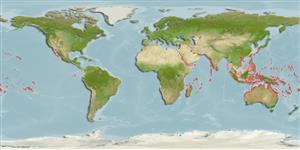Common names from other countries
>
Eupercaria/misc (Various families in series Eupercaria) >
Labridae (Wrasses) > Corinae
Etymology: Thalassoma: Greek, thalassa = the sea + Greek, soma = body; the colour of the sea (Ref. 45335).
More on author: Forsskål.
Environment: milieu / climate zone / depth range / distribution range
นิเวศวิทยา
เกี่ยวกับทะเล,น้ำเค็ม เกี่ยวกับหินโสโครก; ระดับความลึก 0 - 10 m (Ref. 30573). Tropical; 32°N - 32°S
Indo-Pacific: Red Sea and East Africa (Ref. 4392) to the Hawaiian, Marquesan, and Easter islands, north to southern Japan, south to Lord Howe, Kermadec, and Rapa islands. Southeast Atlantic: southeast coast of South Africa (Ref. 4392). Replaced by Thalassoma virens in the Revillagigedo Islands (Ref. 37816).
ขนาด / น้ำหนัก / Age
Maturity: Lm ? range ? - ? cm
Max length : 46.0 cm TL เพศผู้/กระเทย; (Ref. 30573); น้ำหนักสูงสุดที่มีการรายงาน: 1.2 kg (Ref. 40637)
เงี่ยงครีบหลัง (รวม) : 8; ก้านครีบอ่อนที่หาง (รวม) : 12 - 14; เงี่ยงครีบก้น: 3; ก้านครีบอ่อนที่ก้น: 10 - 12. T. purpureum and T. trilobatum have nearly identical initial phases (Ref. 1602). They differ slightly in details of the head markings, and T. purpureum has a slightly longer head, shorter pectoral fins, and attains a larger size (Ref. 1602, 48636). Females best distinguished by the 'V' mark on the snout (Ref. 48636). Initial phase with a vertical dark red line below front of eye usually with a branch to front of snout (Ref 9823).
Found almost exclusively in the surge zone of outer reef flats, reef margins, and rocky coastlines, down to a depth of about 10 m (Ref. 5213). Benthopelagic (Ref. 58302). Occur in groups of females that are spread out over large reef sections and dominated by few males. Males grow much larger than females (Ref. 48636). Feed on small invertebrates (crabs, sea urchins, brittlestars, mollusks), small fishes, echinoids, ophiuroids and polychaetes (Ref. 37816). Protogynous (Ref. 55080).
Life cycle and mating behavior
Maturities | การสืบพันธุ์ | Spawnings | Egg(s) | Fecundities | ตัวอ่อน
Pelagic spawner.
Randall, J.E., G.R. Allen and R.C. Steene, 1990. Fishes of the Great Barrier Reef and Coral Sea. University of Hawaii Press, Honolulu, Hawaii. 506 p. (Ref. 2334)
IUCN Red List Status (Ref. 130435)
CITES (Ref. 128078)
Not Evaluated
Threat to humans
Harmless
Human uses
การประมง: มีการค้าเพียงเล็กน้อย; การตกปลาเป็นกีฬา: ใช่; สถานที่แสดงสัตว์และพืชน้ำ: การค้า
เครื่องมือ
Special reports
Download XML
แหล่งที่มาจากอินเตอร์เน็ต
Estimates based on models
Preferred temperature (Ref.
115969): 24.6 - 29.3, mean 28.3 (based on 3134 cells).
Phylogenetic diversity index (Ref.
82804): PD
50 = 0.5000 [Uniqueness, from 0.5 = low to 2.0 = high].
Bayesian length-weight: a=0.00955 (0.00430 - 0.02123), b=3.06 (2.89 - 3.23), in cm Total Length, based on LWR estimates for this Genus-body shape (Ref.
93245).
ระดับชั้นอาหาร (Ref.
69278): 3.8 ±0.0 se; based on diet studies.
ความสามารถในการกลับคืนสู่ปกติ (Ref.
120179): ขนาดกลาง, เวลาต่ำสุดที่จะทำให้ประชากรเพิ่มขึ้นเป็น 2 เท่าใช้เวลา 1.4 - 4.4 ปี (Preliminary K or Fecundity.).
Fishing Vulnerability (Ref.
59153): Moderate vulnerability (36 of 100).
